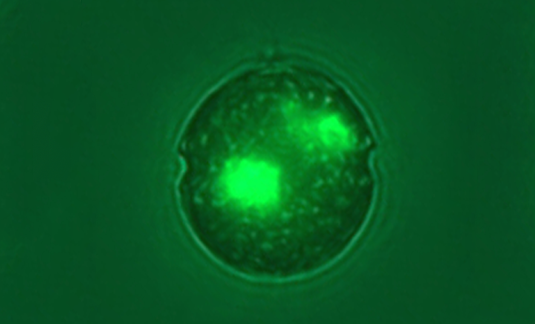Catchy names for exotic algae
LMU biologists have identified two new genera of algae, and named them after well-known industrial musicians. In so doing, they hope to stimulate debate over the guidelines that currently constrain taxonomic nomenclature.
16.05.2017

A specimen of Unruhdinium jiulongensis. Note the nuclei of the dinophyte host (on the left) and its endosymbiotic partner (on the right), a diatom. Image: Haifeng Gu
Unicellular algae, to which the so-called dinophytes belong, are important primary producers in marine and freshwater habitats and, as such, they provide a vital source of food for other organisms. They also serve as indicator organisms, and are used to monitor the status of fish populations, as well as playing an important role in ecosystem modeling. Many dinophyte species are under certain circumstances capable of dominating planktonic communities – giving rise to so-called algal blooms, which are often accompanied by the local accumulation of algal toxins. Given their potential ecological impact, monitoring of changes in dinophyte diversity and population dynamics is advisable – and this of course requires the ability to identify and quantify the present algal species. Researchers led by LMU’s Professor Marc Gottschling, in collaboration with Chinese colleagues, have now identified two new genera of dinophytes, which they named Blixaea and Unruhdinium in honor of the Berlin industrial musicians Blixa Bargeld and N.U. Unruh. These findings appear in the journal Phytotaxa.
In many instances, the systematic definition of algal species is based solely on the morphology of the corresponding type specimens. However, in the era of molecular systematics based on DNA sequencing, this method is no longer adequate. Hence, one of Gottschling’s primary research interests is to revise the taxonomy of algal groups that were originally classified by now outdated methods, focusing in particular on dinophytes. His approach to systematics makes use of freshly collected algae from the type locality which are cultivated under laboratory conditions, and subjected to morphological examination with the electron microscope and sequence-based genetic analysis. The establishment of the genera Blixaea and Unruhdinium forms part of this effort to place the taxonomy of dinophytes on a secure footing. Moreover, the species assigned to the two new taxa belong to an especially fascinating group of dinophytes, informally known as ‘dinotoms’, which exemplify the phenomenon of “tertiary endosymbiosis”. These algae have apparently lost their own photosynthetic organelles, but harbor a diatom or siliceous alga which – in the fashion of a Russian doll – also possess its own plastids. Thanks to their resident diatom, these dinophytes can still carry out photosynthesis. “This group is comprised of only 15 to 20 known species, and is probably most closely related to dinophytes that live as photosynthetic endosymbionts in colonial radiolarians, just like the zooxanthellae found in reef-building corals,” Gottschling explains.
By deciding to name these organisms after members of the band Einstürzende Neubauten, the authors of the new study hope to stimulate discussion as to whether the current guidelines on taxonomic nomenclature, which were formulated early in the last century, have outlived their usefulness. Since then, botanists – unlike their zoological confrères – have avoided naming newly recognised species after individuals who have no personal link with the natural sciences. “In light of the fact that there are myriads of organisms, particularly among the algae and fungi, which have yet to be formally named, it makes little sense to restrict the choice to acceptable terms,” says Gottschling. “What’s more, making the current rules more flexible would represent a return to the tradition initiated by Linnaeus, who named many plant genera after Classical Greek heroes – none of whom became famous for their contributions to botany!
Phytotaxa 2017

